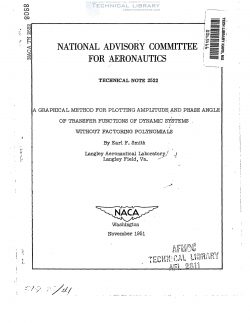naca-tn-2522
- Version
- 35 Downloads
- 1.89 MB File Size
- 1 File Count
- December 15, 2016 Create Date
- December 15, 2016 Last Updated
National Advisory Committee for Aeronautics, Technical Notes - A Graphical Method for Plotting Amplitude and Phase Angle of Transfer Functions of Dynamic Systems without Factoring Polynomials

A method is presented for obtaining amplitude and angle plots for
rational algebraic functions of an imaginary variable. Application of
the method is illustrated by an example in which the frequency response
of an automatically controlled aircraft is plotted. The method involves
the use of templets but does not require the factoring of polynomials.
Amplitude and angle plots of high-degree rational functions of an
imaginary variable can be obtained more rapidly with this method than
by analytical calculation or by methods involving the factoring of
polynomials.
If a dynamic system can be represented by a set of linear differ;
ential equations with constant coefficients and with time as the inde—
pendent variable, the relationship between any output variable of the
system 60 and any input of a system 91 can be obtained in the opera-
tional form.
That is, when any value of forcing frequency w, in radians per second,
is substituted into the function, the amplitude and angle of the
resulting complex value of the function represent the amplification
and phase shift, respectively, through the system when excited at that
frequency.
In the analysis and synthesis of such systems, it is often desira-
ble to obtain plots of the amplification or amplitude A and the phase
shift or phase angle m for the system over a portion of the frequency
spectrum. These plots can be obtained by evaluating the transfer func-
tion of Jm at discrete values of w and plotting amplitude and angle
as functions of m, but this process is tedious and time consuming.
Another method of obtaining the plots is to factor the numerator and
denominator of'the transfer function into first—degree and second—degree
factors and combine them graphically by using templets to represent each
factor on logarithmic coordinates as described in reference 1. But,
when high—degree polynomials are involved, the process of factoring
becomes very tedious.
| File | Action |
|---|---|
| naca-tn-2522 A Graphical Method for Plotting Amplitude and Phase Angle of Transfer Functions of Dynamic Systems without.pdf | Download |
Comment On This Post